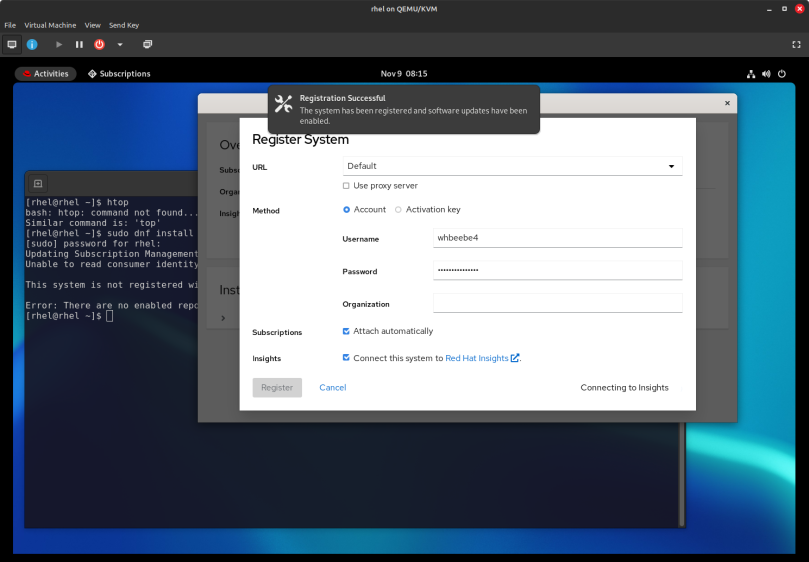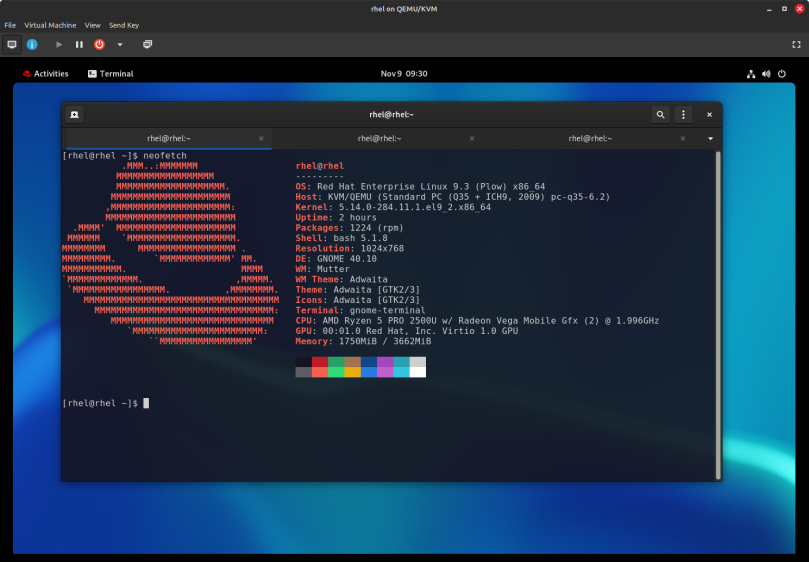I wrote earlier how it was my eventual intent to switch from Linux Mint 21.2 to RHEL 9.2. Before I even had time to plan such a move, The Fedora Project released Fedora 39 two days after I’d downloaded the RHEL 9.2 DVD ISO at 9 GiB. The Fedora 39 ISO, by comparison, weighs in at a svelte 2 GiB. With both ISOs on my little Linux Mint system I’d thought I’d create a QEMU virtual machine of both and give them both a tryout. First up is RHEL.

Since Red Hat has torpedoed the RHEL source code hangers-on, downloading and installing a RHEL clone anonymously has become impossible, assuming you want an up-to-date matching bug-for-bug release that can accept bug fixes and updates over time. Since I’m looking for what will become my future daily driver Linux distribution, I have no problems with either registering with Red Hat for a free developer account or registering the RHEL instance once it’s up and running. That developer account allows me to download for free an up-to-date Red Hat desktop DVD ISO for general personal use, not for resale. I’m sure I could download the server version for free, but that’s not what I’m looking to do.

Once my installed and running Red Hat workstation instance was registered, I was able to update to all the latest RHEL 9.2 patches, as well as install the EPEL repository references and then install a few EPEL packages such as neofetch (see above). That’s when I found out that my starting 9.2 instance had been updated to 9.3 (Plow).
Setting everything set up has been without any drama. If you’ve been working with any Linux distributions over the last two years, then you won’t be surprised at the pure Gnome desktop. Red Hat comes with the added assurance that the critical bugs will get fixed, in spite of what some critics may say.
I now see eye-to-eye with Red Hat’s attitude that groups like the original CentOS (before Red Hat bought it) as well as follow-on Rocky and Alma Linux are free-loaders, and the people who used those re-builds of Red Hat source to underpin their businesses are also free-loaders. If you’re building a business on top of Red Hat Enterprise Linux then you need to price in the cost of RHEL and pay for a copy of RHEL. Open source means free-as-in-speech, not free-as-in-beer. No-where is it written that open software must always be free to use, only free to study and extend as necessary.
Or to borrow the words of the late science fiction author Harlan Ellison, “pay the writer.”
Links
How to install EPEL on RHEL and CentOS Stream — https://www.redhat.com/sysadmin/install-epel-linux
Harlan Ellison’s Wonderful Rant on Why Writers Should Always Get Paid — https://www.openculture.com/2015/11/harlan-ellisons-wonderful-rant-on-why-writers-should-always-get-paid.html


You must be logged in to post a comment.